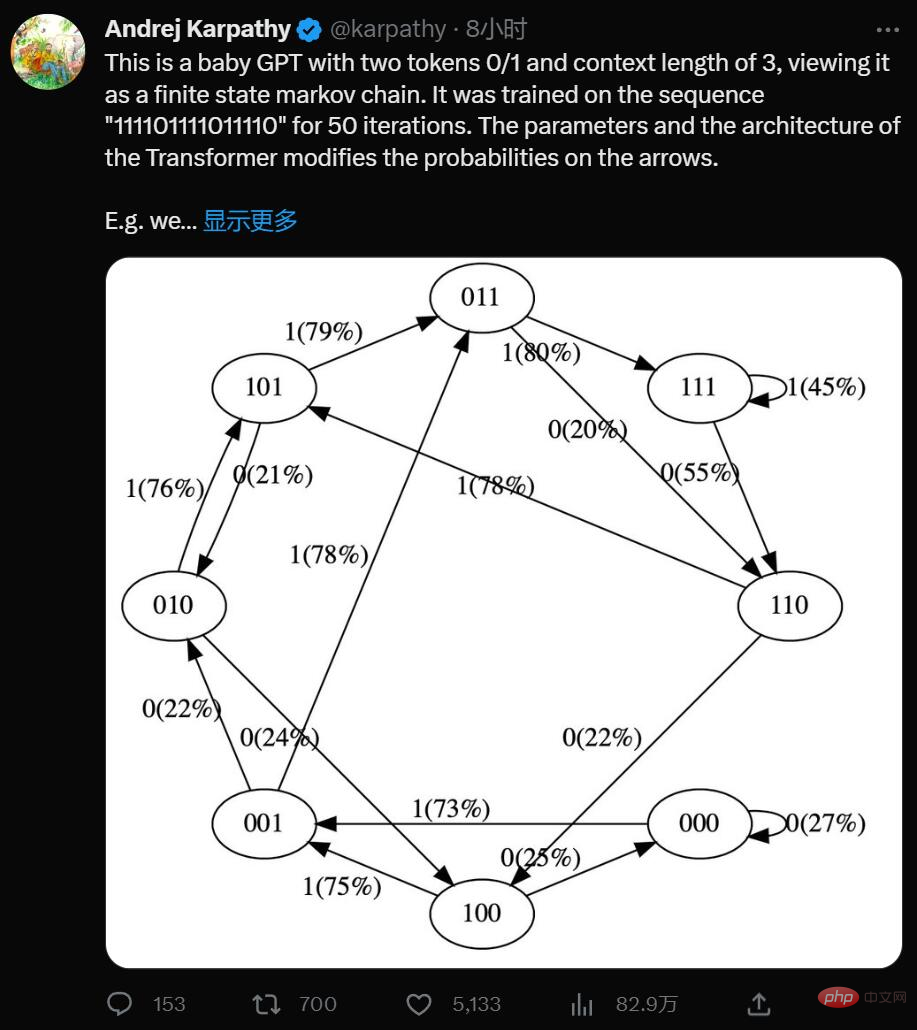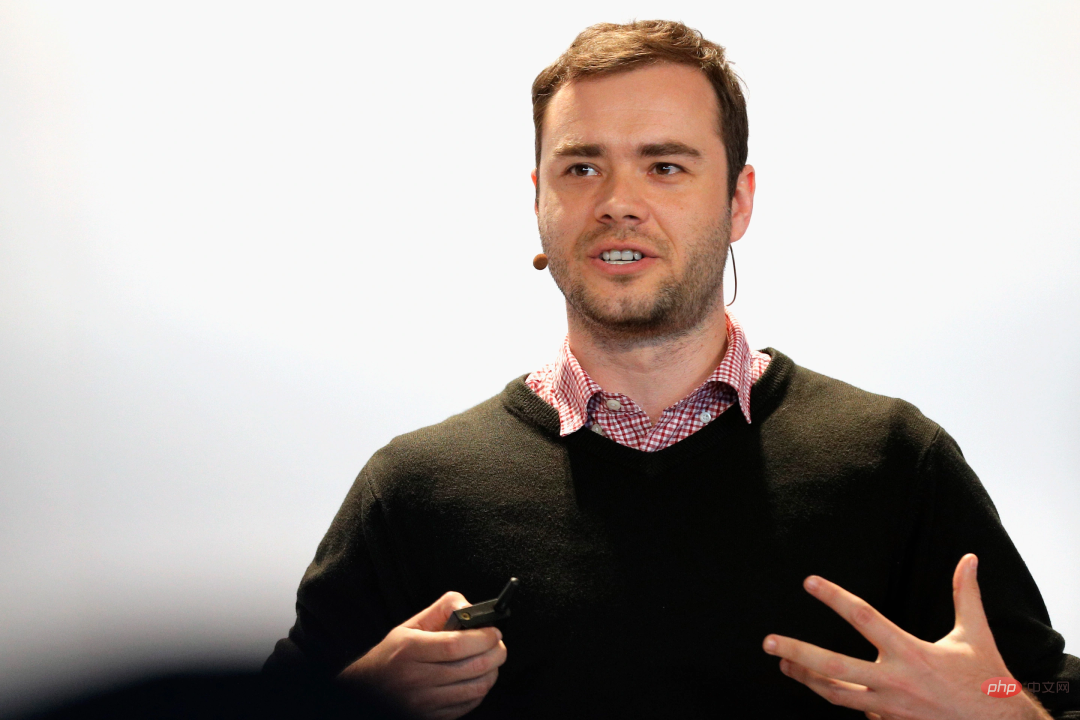Home >Technology peripherals >AI >No need to write code, the simplest BabyGPT model can be made by hand: the new work of the former Tesla AI director
No need to write code, the simplest BabyGPT model can be made by hand: the new work of the former Tesla AI director
- 王林forward
- 2023-04-27 20:25:051064browse
We know that OpenAI’s GPT series has opened a new era of artificial intelligence through large-scale and pre-training methods. However, for most researchers, the language large model (LLM) is due to its size and computing power. Demand seems unattainable. While technology is developing upwards, people have also been exploring the "simplest" GPT model.
Recently, Andrej Karpathy, the former AI director of Tesla and who has just returned to OpenAI, introduced a simplest way to play GPT, which may help more people understand the behind-the-scenes of this popular AI model. technology helps.

Yes, this is a minimalist GPT with two tokens 0/1 and a context length of 3, think of it as limited State Markov chain. It is trained on the sequence "111101111011110" for 50 iterations, and the parameters and architecture of the Transformer modify the probabilities on the arrows.
For example we can see:
- In the training data, state 101 deterministically transitions to 011, so this transition The probability becomes higher (79%). But not close to 100% because only 50 steps of optimization were done here.
- State 111 enters 111 and 110 respectively with 50% probability, which the model has almost learned (45%, 55%).
- A state like 000 is never encountered during training, but has a relatively sharp transition probability, such as 73% going to 001. This is a result of Transformer's inductive bias. You might be thinking this is 50%, except that in real deployments almost every input sequence is unique and does not appear literally in the training data.
Through simplification, Karpathy has made GPT models easy to visualize, allowing you to intuitively understand the entire system.
You can try it here: https://colab.research.google.com/drive/1SiF0KZJp75rUeetKOWqpsA8clmHP6jMg?usp=sharing
In fact, even in the initial version of GPT, the size of the model is quite considerable: in 2018, OpenAI released the first-generation GPT model, which can be seen from the paper "Improving Language Understanding by Generative Pre-Training" It is understood that it uses a 12-layer Transformer Decoder structure and uses about 5GB of unsupervised text data for training.
But if you simplify its concept, GPT is a neural network that takes some discrete token sequences and predicts the probability of the next token in the sequence. For example, if there are only two tokens 0 and 1, then a small binary GPT can tell us for example:
[0,1,0] ---> GPT ---> [P (0) = 20%, P (1) = 80%]
Here, the GPT takes the bit sequence [0,1,0] , and according to the current parameter settings, the probability of predicting the next one to be 1 is 80%. Importantly, GPT's context length is limited by default. If the context length is 3, then they can only use up to 3 tokens on input. In the above example, if we flip a biased coin and sample 1 which should indeed be next, we will transition from the original state [0,1,0] to the new state [1,0,1]. We add a new bit on the right (1) and truncate the sequence to context length 3 by discarding the leftmost bit (0), and this process can be repeated over and over to transition between states.
Obviously, GPT is a finite-state Markov chain: there is a finite set of states and probability transition arrows between them. Each state is defined by a specific setting of tokens at the GPT input (e.g. [0,1,0]). We can transition it to a new state with a certain probability, such as [1,0,1]. Let’s see how it works in detail:
# hyperparameters for our GPT # vocab size is 2, so we only have two possible tokens: 0,1 vocab_size = 2 # context length is 3, so we take 3 bits to predict the next bit probability context_length = 3
The input to the GPT neural network is a sequence of tokens of length context_length. These tokens are discrete, so the state space is simple:
print ('state space (for this exercise) = ', vocab_size ** context_length)
# state space (for this exercise) = 8Details: To be precise, GPT can take any number of tokens from 1 to context_length. So if the context length is 3, in principle we could input 1, 2 or 3 tokens while trying to predict the next token. We ignore this here and assume that the context length is "maximized" just to simplify some of the code below, but it's worth keeping in mind.
print ('actual state space (in reality) = ', sum (vocab_size ** i for i in range (1, context_length+1)))
# actual state space (in reality) = 14我们现在要在 PyTorch 中定义一个 GPT。出于本笔记本的目的,你无需理解任何此代码。
现在让我们构建 GPT 吧:
config = GPTConfig ( block_size = context_length, vocab_size = vocab_size, n_layer = 4, n_head = 4, n_embd = 16, bias = False, ) gpt = GPT (config)
对于这个笔记本你不必担心 n_layer、n_head、n_embd、bias,这些只是实现 GPT 的 Transformer 神经网络的一些超参数。
GPT 的参数(12656 个)是随机初始化的,它们参数化了状态之间的转移概率。如果你平滑地更改这些参数,就会平滑地影响状态之间的转换概率。
现在让我们试一试随机初始化的 GPT。让我们获取上下文长度为 3 的小型二进制 GPT 的所有可能输入:
def all_possible (n, k): # return all possible lists of k elements, each in range of [0,n) if k == 0: yield [] else: for i in range (n): for c in all_possible (n, k - 1): yield [i] + c list (all_possible (vocab_size, context_length))
[[0, 0, 0], [0, 0, 1], [0, 1, 0], [0, 1, 1], [1, 0, 0], [1, 0, 1], [1, 1, 0], [1, 1, 1]]
这是 GPT 可能处于的 8 种可能状态。让我们对这些可能的标记序列中的每一个运行 GPT,并获取序列中下一个标记的概率,并绘制为可视化程度比较高的图形:
# we'll use graphviz for pretty plotting the current state of the GPT
from graphviz import Digraph
def plot_model ():
dot = Digraph (comment='Baby GPT', engine='circo')
for xi in all_possible (gpt.config.vocab_size, gpt.config.block_size):
# forward the GPT and get probabilities for next token
x = torch.tensor (xi, dtype=torch.long)[None, ...] # turn the list into a torch tensor and add a batch dimension
logits = gpt (x) # forward the gpt neural net
probs = nn.functional.softmax (logits, dim=-1) # get the probabilities
y = probs [0].tolist () # remove the batch dimension and unpack the tensor into simple list
print (f"input {xi} ---> {y}")
# also build up the transition graph for plotting later
current_node_signature = "".join (str (d) for d in xi)
dot.node (current_node_signature)
for t in range (gpt.config.vocab_size):
next_node = xi [1:] + [t] # crop the context and append the next character
next_node_signature = "".join (str (d) for d in next_node)
p = y [t]
label=f"{t}({p*100:.0f}%)"
dot.edge (current_node_signature, next_node_signature, label=label)
return dot
plot_model ()input [0, 0, 0] ---> [0.4963349997997284, 0.5036649107933044] input [0, 0, 1] ---> [0.4515703618526459, 0.5484296679496765] input [0, 1, 0] ---> [0.49648362398147583, 0.5035163760185242] input [0, 1, 1] ---> [0.45181113481521606, 0.5481888651847839] input [1, 0, 0] ---> [0.4961162209510803, 0.5038837194442749] input [1, 0, 1] ---> [0.4517717957496643, 0.5482282042503357] input [1, 1, 0] ---> [0.4962802827358246, 0.5037197470664978] input [1, 1, 1] ---> [0.4520467519760132, 0.5479532480239868]
我们看到了 8 个状态,以及连接它们的概率箭头。因为有 2 个可能的标记,所以每个节点有 2 个可能的箭头。请注意,在初始化时,这些概率中的大多数都是统一的(在本例中为 50%),这很好而且很理想,因为我们甚至根本没有训练模型。
下面开始训练:
# let's train our baby GPT on this sequence seq = list (map (int, "111101111011110")) seq
[1, 1, 1, 1, 0, 1, 1, 1, 1, 0, 1, 1, 1, 1, 0]
# convert the sequence to a tensor holding all the individual examples in that sequence
X, Y = [], []
# iterate over the sequence and grab every consecutive 3 bits
# the correct label for what's next is the next bit at each position
for i in range (len (seq) - context_length):
X.append (seq [i:i+context_length])
Y.append (seq [i+context_length])
print (f"example {i+1:2d}: {X [-1]} --> {Y [-1]}")
X = torch.tensor (X, dtype=torch.long)
Y = torch.tensor (Y, dtype=torch.long)
print (X.shape, Y.shape)我们可以看到在那个序列中有 12 个示例。现在让我们训练它:
# init a GPT and the optimizer torch.manual_seed (1337) gpt = GPT (config) optimizer = torch.optim.AdamW (gpt.parameters (), lr=1e-3, weight_decay=1e-1)
# train the GPT for some number of iterations for i in range (50): logits = gpt (X) loss = F.cross_entropy (logits, Y) loss.backward () optimizer.step () optimizer.zero_grad () print (i, loss.item ())
print ("Training data sequence, as a reminder:", seq)
plot_model ()我们没有得到这些箭头的准确 100% 或 50% 的概率,因为网络没有经过充分训练,但如果继续训练,你会期望接近。
请注意一些其他有趣的事情:一些从未出现在训练数据中的状态(例如 000 或 100)对于接下来应该出现的 token 有很大的概率。如果在训练期间从未遇到过这些状态,它们的出站箭头不应该是 50% 左右吗?这看起来是个错误,但实际上是可取的,因为在部署期间的真实应用场景中,几乎每个 GPT 的测试输入都是训练期间从未见过的输入。我们依靠 GPT 的内部结构(及其「归纳偏差」)来适当地执行泛化。
大小比较:
- GPT-2 有 50257 个 token 和 2048 个 token 的上下文长度。所以 `log2 (50,257) * 2048 = 每个状态 31,984 位 = 3,998 kB。这足以实现量变。
- GPT-3 的上下文长度为 4096,因此需要 8kB 的内存;大约相当于 Atari 800。
- GPT-4 最多 32K 个 token,所以大约 64kB,即 Commodore64。
- I/O 设备:一旦开始包含连接到外部世界的输入设备,所有有限状态机分析就会崩溃。在 GPT 领域,这将是任何一种外部工具的使用,例如必应搜索能够运行检索查询以获取外部信息并将其合并为输入。
Andrej Karpathy 是 OpenAI 的创始成员和研究科学家。但在 OpenAI 成立一年多后,Karpathy 便接受了马斯克的邀请,加入了特斯拉。在特斯拉工作的五年里,他一手促成了 Autopilot 的开发。这项技术对于特斯拉的完全自动驾驶系统 FSD 至关重要,也是马斯克针对 Model S、Cybertruck 等车型的卖点之一。
今年 2 月,在 ChatGPT 火热的背景下,Karpathy 回归 OpenAI,立志构建现实世界的 JARVIS 系统。

最近一段时间,Karpathy 给大家贡献了很多学习材料,包括详解反向传播的课程 、重写的 minGPT 库、从零开始构建 GPT 模型的完整教程等。
The above is the detailed content of No need to write code, the simplest BabyGPT model can be made by hand: the new work of the former Tesla AI director. For more information, please follow other related articles on the PHP Chinese website!
Related articles
See more- Technology trends to watch in 2023
- How Artificial Intelligence is Bringing New Everyday Work to Data Center Teams
- Can artificial intelligence or automation solve the problem of low energy efficiency in buildings?
- OpenAI co-founder interviewed by Huang Renxun: GPT-4's reasoning capabilities have not yet reached expectations
- Microsoft's Bing surpasses Google in search traffic thanks to OpenAI technology

